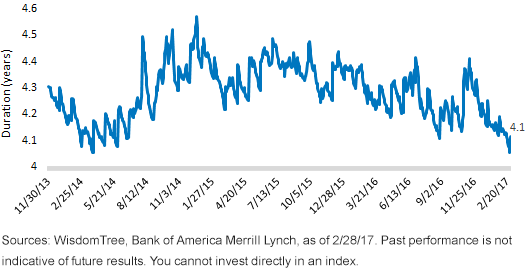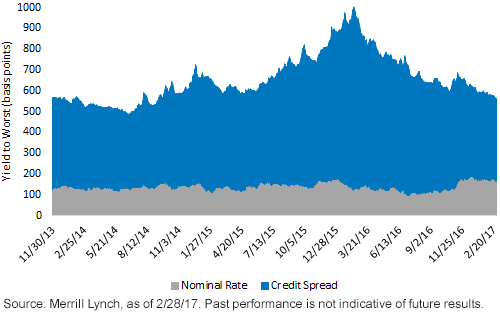Playing Better Defense with Rate-Hedged High-Yield Bonds


In our weekly asset allocation meetings, a key debate to start 2017 centered on whether the Federal Open Market Committee would hike interest rates three times over the course of the calendar year. After the Fed’s rate hike on March 15, our debates have now shifted to whether it may be necessary for the Fed to hike four times in 2017. While the answer to this question will be important for all asset classes, our primary focus has been on what impact this will have on bond markets going forward. With global economic activity accelerating, a commonsense trade has been to be over-weight high-yield debt as the outlook for risky borrowers continues to improve. While we have long advocated for this shift in portfolios, we believe there may be a more intuitive way for investors to play defense via interest rate-hedged high-yield bonds.
Why High Yield?
All else being equal, investors typically reduce interest rate risk (as measured by duration) in three simple ways: reduce maturity, swap fixed coupon bonds for floating rate or decrease credit quality. Given that the market tends to require that riskier borrowers pay higher coupon rates than investment-grade (IG) borrowers, bonds with the same maturity tend to have a lower duration. Additionally, given that yields also tend to be higher, investors also have a greater amount of “cushion” that can be used to dampen losses from rising interest rates. Therefore, high yield tends to outperform as rates rise.
Why Hedge?
While we currently believe that investors will be rewarded for assuming more credit risk in their portfolio, one of the most commonly cited fallacies we’ve been hearing is that high-yield debt doesn’t have interest rate risk. As we show in the chart below, this is definitely not the case.
BofA Merrill Lynch U.S. High-Yield Index, 11/30/13/–2/28/2017

While investors may not feel the pain as acutely as with lower-yielding, longer-duration investments, bond math continues to work the same for high yield. As we’ve written previously, early rate hikes in the U.S. tend to occur during periods of economic expansion. As a result, credit spreads tend to tighten, boosting high-yield bond prices. However, if we think about the two primary contributors to a bond’s yield—nominal interest rate risk and credit risk—by owning a high-yield strategy unhedged, you may benefit from declining credit spreads, but then see those gains offset by an increase in nominal interest rates.
Contribution to Yield, 11/30/13–2/28/17

For definitions of terms in the chart, visit our glossary.
In our view, this trade may cause frustration similar to what many investors felt investing in international equities from 2012 through mid-2016—making the correct call on equities only to see their profits evaporate due to a strengthening U.S. dollar. This is precisely the reason WisdomTree helped to develop interest rate-hedged bond indexes. As we have found in our research, nominal interest rates are the primary driver of the cost of hedging. With the cost of hedging approximately 81 basis points (bps) per year,1 we view this as a compelling trade-off given the prospect for higher nominal rates.
Conclusion
If investors are seeking to protect their portfolio from rising rates by increasing allocations to high yield, we feel it’s counterintuitive to own a bond strategy simply because it’s going to lose less than an IG strategy. In our view, exchange-traded funds can be used as powerful tools to help isolate credit risk in a bond portfolio through interest rate-hedged bond strategies like the WisdomTree Interest Rate Hedged High Yield Bond Fund (HYZD).
1Source: WisdomTree, as of 3/3/17. WisdomTree’s strategy seeks to track the performance of the BofA Merrill Lynch 0-5 Year US High Yield Constrained, Zero Duration Index.
Important Risks Related to this Article
There are risks associated with investing, including possible loss of principal. High-yield or “junk” bonds have lower credit ratings and involve a greater risk to principal. Fixed income investments are subject to interest rate risk; their value will normally decline as interest rates rise. The Fund seeks to mitigate interest rate risk by taking short positions in U.S. Treasuries, but there is no guarantee this will be achieved. Derivative investments can be volatile, and these investments may be less liquid than other securities, and more sensitive to the effects of varied economic conditions.
Fixed income investments are also subject to credit risk, the risk that the issuer of a bond will fail to pay interest and principal in a timely manner or that negative perceptions of the issuer’s ability to make such payments will cause the price of that bond to decline. The Fund may engage in “short sale” transactions where losses may be exaggerated, potentially losing more money than the actual cost of the investment, and the third party to the short sale may fail to honor its contract terms, causing a loss to the Fund. While the Fund attempts to limit credit and counterparty exposure, the value of an investment in the Fund may change quickly and without warning in response to issuer or counterparty defaults and changes in the credit ratings of the Fund’s portfolio investments. Due to the investment strategy of certain Funds, they may make higher capital gain distributions than other ETFs. Please read the Fund’s prospectus for specific details regarding the Fund’s risk profile.


